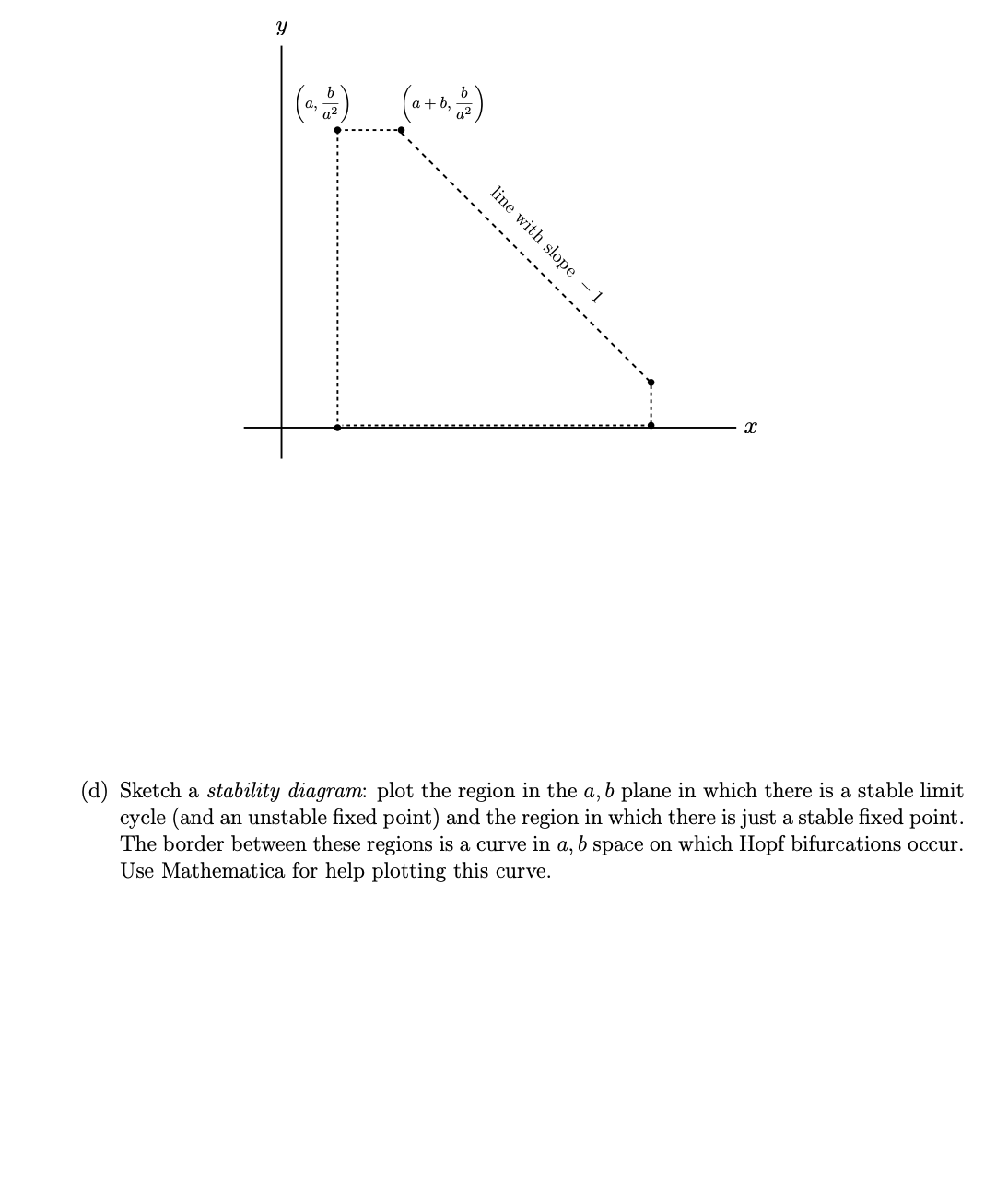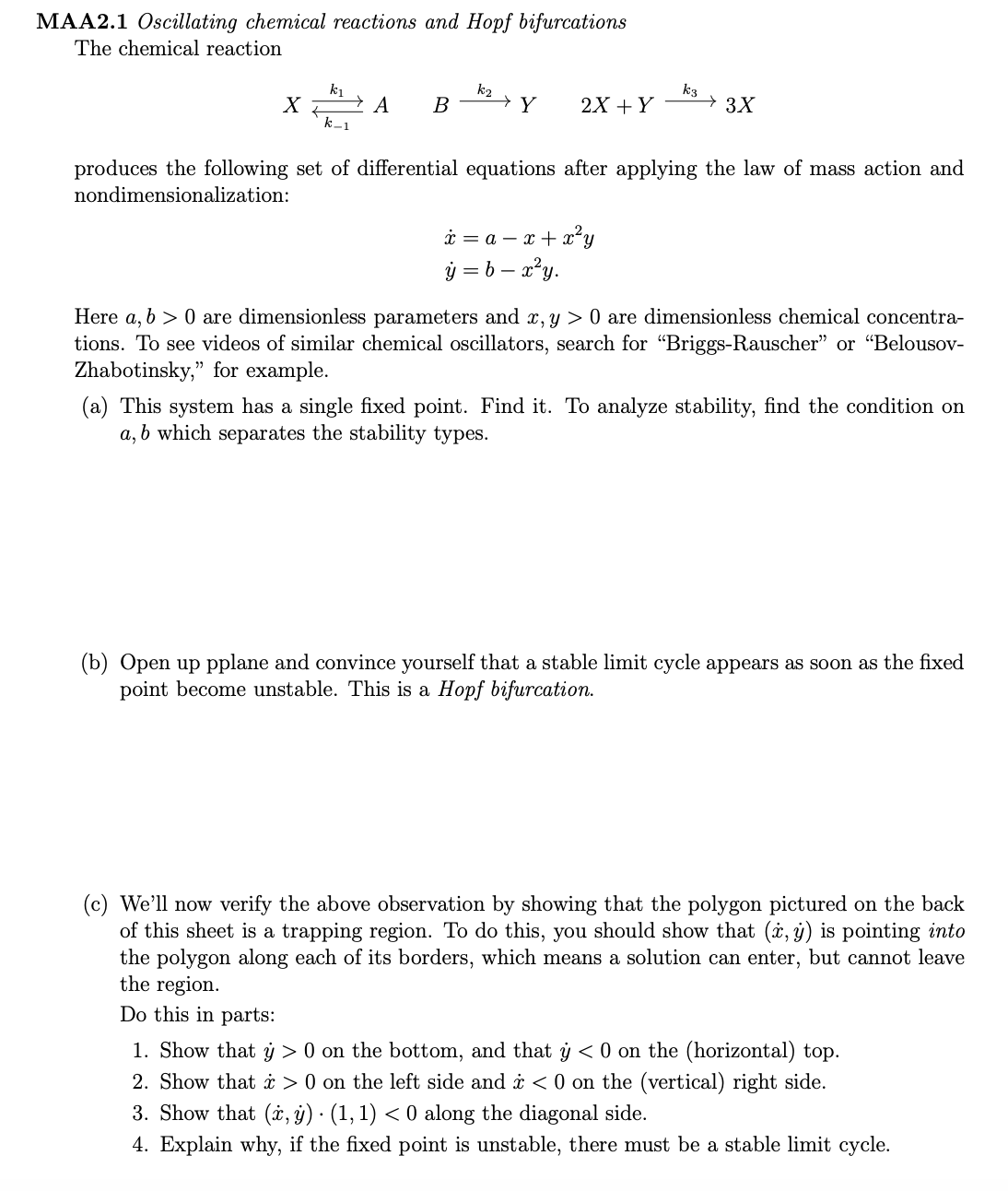d) Sketch a stability diagram: plot the region in the a, b plane in which there is a stable limit cycle (and an unstable fixed point) and the region in which there is just a stable fixed point. The border between these regions is a curve in a, b space on which Hopf bifurcations occur. Use Mathematica for help plotting this curve.
d) Sketch a stability diagram: plot the region in the a, b plane in which there is a stable limit cycle (and an unstable fixed point) and the region in which there is just a stable fixed point. The border between these regions is a curve in a, b space on which Hopf bifurcations occur. Use Mathematica for help plotting this curve.
Advanced Engineering Mathematics
10th Edition
ISBN:9780470458365
Author:Erwin Kreyszig
Publisher:Erwin Kreyszig
Chapter2: Second-order Linear Odes
Section: Chapter Questions
Problem 1RQ
Related questions
Question
Answer for part d.

Transcribed Image Text:y
|(9,5)
(a +6, 5)
b₂
line with slope - 1
X
(d) Sketch a stability diagram: plot the region in the a, b plane in which there is a stable limit
cycle (and an unstable fixed point) and the region in which there is just a stable fixed point.
The border between these regions is a curve in a, b space on which Hopf bifurcations occur.
Use Mathematica for help plotting this curve.

Transcribed Image Text:MAA2.1 Oscillating chemical reactions and Hopf bifurcations
The chemical reaction
X
k₁
k_1
A
B
Y 2X + Y
k3
x = a − x + x²y
y=b-x²y.
→ 3X
produces the following set of differential equations after applying the law of mass action and
nondimensionalization:
Here a, b>0 are dimensionless parameters and x, y > 0 are dimensionless chemical concentra-
tions. To see videos of similar chemical oscillators, search for "Briggs-Rauscher" or "Belousov-
Zhabotinsky," for example.
(a) This system has a single fixed point. Find it. To analyze stability, find the condition on
a, b which separates the stability types.
(b) Open up pplane and convince yourself that a stable limit cycle appears as soon as the fixed
point become unstable. This is a Hopf bifurcation.
(c) We'll now verify the above observation by showing that the polygon pictured on the back
of this sheet is a trapping region. To do this, you should show that (x, y) is pointing into
the polygon along each of its borders, which means a solution can enter, but cannot leave
the region.
Do this in parts:
1. Show that y> 0 on the bottom, and that y < 0 on the (horizontal) top.
2. Show that > 0 on the left side and <0 on the (vertical) right side.
3. Show that (x, y) ∙ (1, 1) < 0 along the diagonal side.
4. Explain why, if the fixed point is unstable, there must be a stable limit cycle.
Expert Solution
This question has been solved!
Explore an expertly crafted, step-by-step solution for a thorough understanding of key concepts.
Step by step
Solved in 3 steps with 2 images

Recommended textbooks for you

Advanced Engineering Mathematics
Advanced Math
ISBN:
9780470458365
Author:
Erwin Kreyszig
Publisher:
Wiley, John & Sons, Incorporated

Numerical Methods for Engineers
Advanced Math
ISBN:
9780073397924
Author:
Steven C. Chapra Dr., Raymond P. Canale
Publisher:
McGraw-Hill Education

Introductory Mathematics for Engineering Applicat…
Advanced Math
ISBN:
9781118141809
Author:
Nathan Klingbeil
Publisher:
WILEY

Advanced Engineering Mathematics
Advanced Math
ISBN:
9780470458365
Author:
Erwin Kreyszig
Publisher:
Wiley, John & Sons, Incorporated

Numerical Methods for Engineers
Advanced Math
ISBN:
9780073397924
Author:
Steven C. Chapra Dr., Raymond P. Canale
Publisher:
McGraw-Hill Education

Introductory Mathematics for Engineering Applicat…
Advanced Math
ISBN:
9781118141809
Author:
Nathan Klingbeil
Publisher:
WILEY

Mathematics For Machine Technology
Advanced Math
ISBN:
9781337798310
Author:
Peterson, John.
Publisher:
Cengage Learning,

